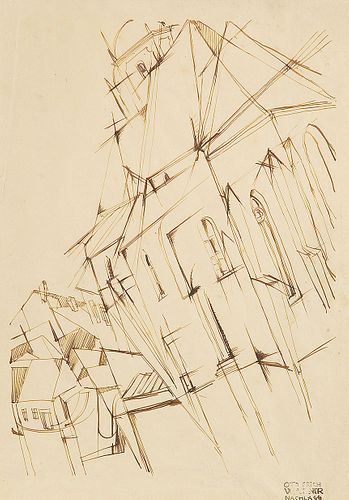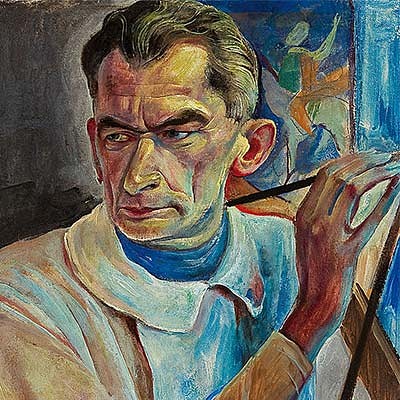OTTO ERICH WAGNER* (Kleppel 1895 - 1979 Vienna)
Lot 14
Estimate:
EUR€800 - EUR€1,500
$860.22 - $1,612.90
Absentee vs Live bid
Two ways to bid:
- Leave a max absentee bid and the platform will bid on your behalf up to your maximum bid during the live auction.
- Bid live during the auction and your bids will be submitted real-time to the auctioneer.
Bid Increments
| Price | Bid Increment |
|---|---|
| EUR€0 | EUR€10 |
| EUR€100 | EUR€50 |
| EUR€700 | EUR€100 |
| EUR€1,000 | EUR€200 |
| EUR€3,000 | EUR€300 |
| EUR€3,600 | EUR€400 |
| EUR€4,000 | EUR€500 |
| EUR€7,000 | EUR€1,000 |
| EUR€16,000 | EUR€2,000 |
| EUR€30,000 | EUR€3,000 |
| EUR€36,000 | EUR€4,000 |
| EUR€40,000 | EUR€5,000 |
| EUR€150,000 | EUR€10,000 |
About Auction
By Widder Auctions
Nov 28, 2022
Set Reminder
2022-11-28 10:00:00
2022-11-28 10:00:00
America/New_York
Bidsquare
Bidsquare : Viennese Art Nouveau, Expressionism, Modern Art
https://www.bidsquare.com/auctions/widder-auctions/viennese-art-nouveau-expressionism-modern-art-10414
Widder Auctions office@widderauktionen.com
Widder Auctions office@widderauktionen.com
- Lot Description
OTTO ERICH WAGNER*
(Kleppel 1895 - 1979 Vienna)
Church
pencil/paper, 38.5 x 27.2 cm
estate stamp Otto Erich Wagner
provenance: private collection Vienna
ESTIMATE #Euro 800 - 1.500
STARTING PRICE #Euro 600
Austrian artist and art educator. After his war service, Otto Erich Wagner studied with Franz Čižek and Rudolf Larisch at the Vienna School of Applied Arts, and from 1924 he was an assistant teacher in Čižek's class for general form theory. In addition, he taught interior and garden architecture. In 1925 he participated in the International Exhibition of Decorative Arts in Paris. After Čižek's retirement, Wagner was taken over by Ceno Kosak. He also taught at the Franz-Joseph-Realgymnasium. During World War II and under the Nazi regime, he continued to work at the School of Arts and Crafts as an assistant teacher. In 1944/45 Wagner was conscripted and sent to Yugoslavia. After his return from captivity, he joined the Vienna Secession in 1949 and worked as a freelance artist. Wagner's works were influenced by Viennese Kinetism, whose most important representative was Erika Giovanna Klien. Wagner, who graduated from the Teacher Training College in Vienna between 1919 and 1923 and also took classes at the Vienna School of Applied Arts from 1922 to 1924 with Franz Čižek and Rudolf Larisch, ranks among the abstract artists in interwar Austria along with Elisabeth Karlinsky, Erika Giovanna Klien, My Ullmann, Karl Steiner, and Alois Wachsmann. It is thanks to Franz Čižek and his course in ornamental form theory that the tendencies toward abstraction that had begun in France and Italy before World War I were now also being considered in Austria as a stylistic alternative to the prevailing representational mode of representation. Otto Erich Wagner, who had been friends with Egon Schiele and only became a member of the Vienna Secession in 1949, rose to become one of the most important representatives of Viennese Kinetism. This dominant Viennese art movement of the twenties was based on Italian Futurism and attempted to introduce the rhythms of movement and sounds into the two-dimensionality of the picture plane. Because very few of Čižek's students went on to the Wiener Werkstaetten or other companies, this art movement disappeared from the scene again disappeared from the scene within a few years. In Wagner's kineticist oeuvre, suggestions from Giacomo Balla, Johannes Itten, Franz Marc, Picasso and Kandinsky, Robert Delaunay or El Lissitzky also shimmer through.
PLEASE NOTE:
The purchase price consists of the highest bid plus the buyer's premium, sales tax and, if applicable, the fee of artists resale rights. In the case of normal taxation (marked #), a premium of 24% is added to the highest bid. The mandatory sales tax of 13%, for photographys 20%, is added to the sum of the highest bid and the buyer's premium. The buyer's premium amounts to 28% in case of differential taxation. The sales tax is included in the differential taxation. - Shipping Info
-
We will send you the invoice shortly after the auction. As soon as we have recieved the amount, the art can be picked up at Johannesgasse 9-13, 1010 Vienna. Please note that the buyer is responsible for pick-up and shipping of the lot. Should you wish to ship your items, please contact: Mailboxes Email: oper@mbe-co.at Tel: 01 5128855 Please note that storage fees may apply, should the pieces not be picked up within 14 days after invoicing for domestic and 28 days for international transportation. Our team will be happy to assist you with any further information at office@widderauktionen.com or at 0043 676 555 66 10.
-
- Buyer's Premium



 EUR
EUR CAD
CAD AUD
AUD GBP
GBP MXN
MXN HKD
HKD CNY
CNY MYR
MYR SEK
SEK SGD
SGD CHF
CHF THB
THB













